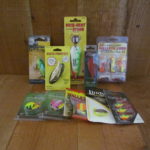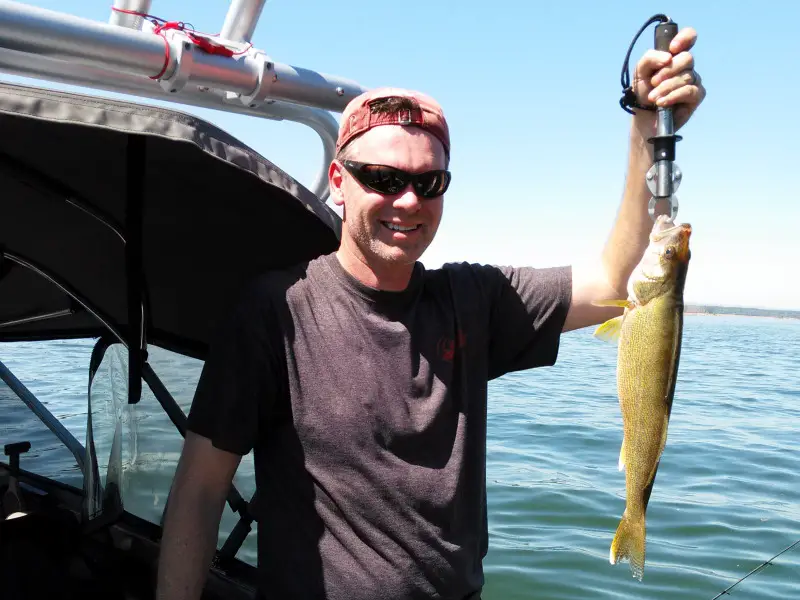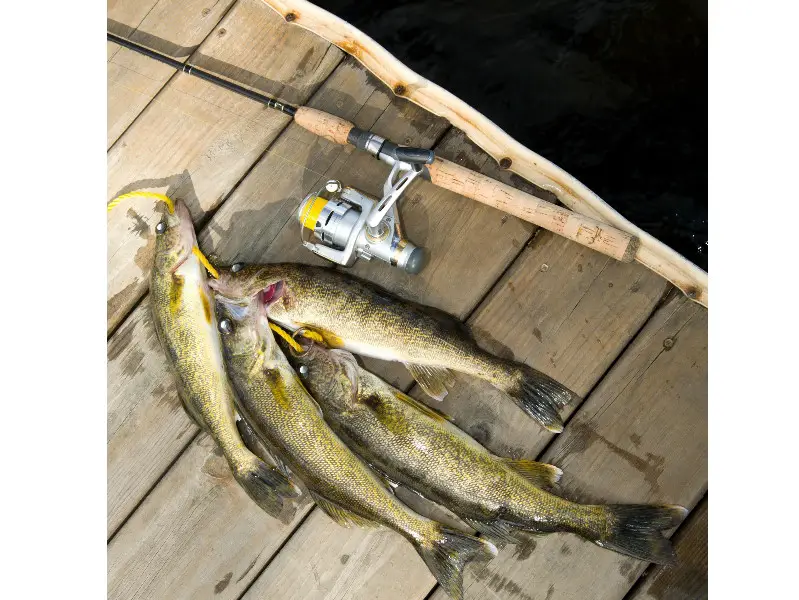On average, Walleyes can grow up to 39 inches (99 cm) in length, with the largest recorded walleye being 42 inches (107 cm). So does that mean you should try to get the biggest walleye you can? Or is there a sweet spot, and you should only consider keeping a walleye of a particular size?
You should keep a walleye 14-18 inches (35.5-45.7 cm) long if you plan on eating them and over 28 inches (71.2 cm) if you want a wall hanger. However, don’t forget to check with the local state regulations, as they might have a specific length limit for the walleyes that you can keep.
This article gives a comprehensive take on what size walleye you should ideally keep and what size walleye you should throw back into the water.
What Size Walleye Should You Keep as a Trophy Fish?
It’s advisable to catch and release larger walleyes back into the water so they can repopulate their habitat. However, it’s fine if you occasionally catch and keep a big one as a trophy or wall hanger.
The average size of walleyes will vary depending on where you fish. Warm water walleyes grow larger more quickly compared to walleyes that live in cooler waters.
That being the case, throughout the US and Canada, walleyes are commonly found between 26-28 inches (66-71.2 cm) long.
Most walleyes larger than 28 inches (71.2 cm) are considered keeper trophy fish for most people.
What Size Walleye Should You Keep for Eating?
Walleyes that are 14-18 inches (35.5-45.7 cm) taste the best. They have a signature subtle-sweet flavoring coupled with extremely low fishiness. They also make excellent juicy and flaky filets that melt in your mouth like butter. The texture is also unique, being firm and delicate at the same time.
You can also find a similar taste profile on walleyes smaller than 14 inches (35.5 cm). But the small size means you’ll have less meat. This is why it’s better to release smaller walleyes back into the water so they can grow bigger.
In contrast, the taste profile diminishes as walleyes grow larger than 18 inches (47.5 cm). Bigger walleyes tend to taste more fishy compared to smaller ones. It’s also harder to cook their filets as they are very thick. It often requires you to overcook the outer layers to ensure the interior is properly cooked.
Here’s a short 1-min YouTube video showcasing the difference between the quality of the fish meat of a bigger walleye and a smaller one:
However, remember to cook the walleye thoroughly before consumption. Walleyes, or any freshwater fish, can carry harmful parasites. Eating them raw can make you very sick.
It’s also worth noting that larger walleyes have more toxins in them. Since the big ones are older and most likely at the top of the food chain in their respective ecosystems, they are exposed to more toxins. Naturally, if you eat them, you can end up really ill. This holds true for all large fishes like tuna, swordfish, etc., and not just walleye.
How Long Can You Store a Walleye That You Plan on Eating?
A fresh uncut walleye will retain its taste and texture for up to a week if you store it in proper refrigerated conditions. This means surrounding the fish with fresh ice and placing it inside a refrigerator to maintain a steady temperature of 30-34°F (-1 to 1°C).
Even if a week has passed, the walleye should still be edible if you store it at the recommended temperature. However, it won’t taste as good as a freshly caught walleye past the one-week point. Ideally, you shouldn’t refrigerate a walleye for longer than one week.
If you plan to eat your catch a month later, it’s better to release it back into the water and come again after a month when you know you’ll have it within a day or two.
It’s also worth noting that the shelf life of a walleye, just like any other fish, will drastically decrease if it’s been cut, fileted, or portioned. In case of a cut walleye, use it within 2-3 days.
Also, when storing the portioned walleye pieces, place them inside a sealed plastic container, and then cover the container with ice. Don’t let the ice directly touch the walleye pieces, as that can damage the meat and ruin the taste.
Finally, if you are in a situation where you can’t eat your fish in three days, consider freezing your walleye. Vacuum-sealed fish is a great way to maintain freshness when freezing them, or you can place the fish in a ziplock bag and remove as much air as possible.
Why You Shouldn’t Keep Larger Walleyes
I already discussed that larger walleyes don’t taste as good as smaller ones. However, apart from taste preferences, the main problem with catching and keeping larger walleyes is that they are the ones repopulating the waters with more walleyes. As such, overfishing the big ones will end up decreasing the overall walleye population.
In reference to walleye spawning, male walleyes reach sexual maturity by the time they are 2-4 years old, while females are ready to lay eggs when they are 4-5. This is why it’s best to avoid catching and keeping walleyes that are 4 years or older. But how do you know the age of a walleye?
Walleyes keep growing in size as they grow older. On average, a 4-5-year-old walleye is around 18-22 inches (45.7-55.8 cm) long. This is why we should avoid trying to catch and keep walleyes larger than 18 inches (45.7 cm).
Are Really Large Walleyes Still Fertile?
A walleye’s lifespan usually depends on where they live, which includes both the place’s climate and the water body’s condition. In some waters, there are even 25 plus-year-old walleyes swimming around. However, these are extremely rare.
On average, walleyes live to be 7 years of age, growing up to 26 inches (66 cm) long.
So, if you catch a walleye longer/older than this, does that mean it’s less fertile and keeping them is okay?
There’s a misconception that older walleyes are less fertile than younger ones. On the contrary, older walleyes are more prominent, which means they carry more eggs and contribute considerably to repopulating their habitat.
The older walleyes also have better genetics — one of the reasons why they were able to live this long. And so, it’s not okay to fish out larger walleyes because they are older and therefore sterile. This is not true.
Conclusion
If you want to eat your catch, you should keep walleyes that are 14-18 inches (35.5-45.7 cm) long as they taste the best. You can catch and keep smaller walleyes but have significantly less meat. It’s better to let them lose so they can grow bigger.
Larger walleyes are responsible for spawning and repopulating the water body. They also don’t taste good, are difficult to cook, and have high toxin content. This is why you shouldn’t hunt them for food.
However, keeping a walleye larger than 28-inches (71.2 cm) as a trophy fish is generally okay.





